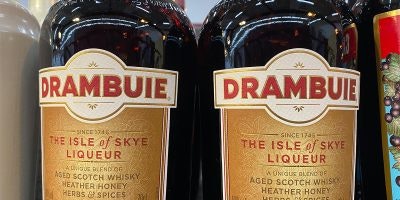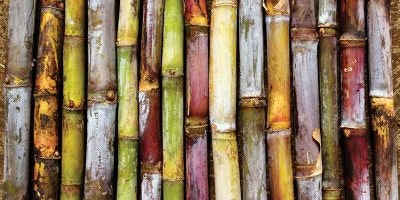Angostura is one of the most well known brands in booze, but there’s more to explore than the brand’s ubiquitous bitters. Located in Port of Spain, Trinidad and Tobago, The House of Angostura also makes rum. Furthermore, it produces a few spinoffs that take those bitters in a new direction, including an amaro. Visiting the distillery offers an opportunity to explore the brand’s entire spirits lineup. In addition, you can learn a bit more about the secretive art of bitters production.
Making Angostura Rum
The House of Angostura built its rum distillery in Port of Spain in 1947, following a period where they had been blending and selling rums produced elsewhere. Molasses is the base for its spirits, and the brand has been using the same yeast strain since production began.
Production outside at the House of Angostura /Photo Credit: House of Angostura
Angostura rums are column-distilled using a combination of two rigs. The first is a large single column system responsible for their heavy rum production. Their five-column setup handles the light rum production. If such a setup sounds familiar, it’s largely on par with Puerto Rican rum production, as a point of comparison.
The idea is to keep enough flavor components on hand while also ensuring a clean spirit. According to Angostura’s long-serving—though now semi-retired—master distiller John Georges, you want to keep just enough of the funky stuff.
But even Georges will concede that the real fun begins after distillation, and after maturation, for that matter. For Angostura rums, ex-bourbon casks are primarily used for maturation. The brand has somewhere between 60,000 and 80,000 rum barrels spread out across its five current warehouses.
After aging the styles of rums individually, it’s time for the rums to be born in full via blending. “The truth is the blenders is where the real magic begins,” says Georges.
It should be noted the House of Angostura uses barrels multiple times, and will also combine and re-cask barrels depleted by the tropical angel’s share.
Tasting an Angostura Rum Flight
Reserva: This is a three year-old rum filtered to be clear. Reserva initially shows cinnamon and baking spices along with soft citrus notes. Butterscotch and cocoa notes are found towards the back.
Angostura Rums /Photo Credit: House of Angostura
1919: This blend is between five and 10 years. Its light, vanilla-forward profile is backed by spicy oak.
7 Year: A honeyed palate with citrus peels and chocolate syrup is found in Angostura 7 Year. It gets peppery on the finish. Georges says it’s his current go-to in the lineup.
1824: It’s aged for a minimum of 12 years before being blended and married back in-cask. 1824 showcases smoky molasses and a rich palate.
1787: Aged for a minimum of 15 years, 1787 offers more of an estery nose with tropical fruits. The palate displays dark chocolate and tannic oak.
Other rums in its portfolio include offerings such as the Fernandes lineup of rums, as well as White Oak, the best selling rum in Trinidad & Tobago. The other rum brands the House of Angostura sells to aren’t disclosed. But a bit of digging can reveal some likely candidates you may be familiar with by name.
Those Famous Bitters
Angostura Bitters were initially made in 1824 by company founder Dr. Johann Siegert, in the town of Angostura, Venezuela (now known as the Ciudad Bolívar). Siegert’s sons moved the company to Trinidad in 1875 where it remains to this day.
Angostura Bitters /Photo Credit: House of Angostura
“This product is made exactly the same way it was 196 years ago,” says Peter Sandström, the new CEO of Angostura Limited. But the details of just how exactly it is made are known to just a core group of five master makers. Don’t expect to find them in the same room at the same time, either.
What is known is that after a batch of botanicals is precisely weighed out bit-by-bit, a percolator extraction system is used with 55% ABV rum as the base liquid. This process continues for four hours, before brown sugar and caramel color are added. The resulting liquid is left to rest in large tanks for three months before it’s proofed down to 44.7% ABV. Finally, it’s bottled with its signature high-label.
Iconic Label
That appearance, by the way, with the paper label extending higher than the bottle’s body wasn’t intentional. It was the result of some familial miscommunication between the brother responsible for the bottles and the brother responsible for the labels prior to a competition in the 19th century. It’s become iconic in the way that few bottles ever have, perhaps alongside the red wax of Maker’s Mark.
Angostura Bitters and Amaro /Photo Credit: House of Angostura
The secret Angostura recipe, meanwhile, is something that’s enforced not only within the company but also with help from the government as well. For instance, import containers holding key botanicals for Angostura aren’t opened, to avoid the prying eyes of interlopers. Moreover, suspicion of theft from the distillery can quickly lead to both fines and jail time.
Angostura’s recipe is starting to appear in other places, though. Namely Amaro di Angostura, the brand’s amaro. While there are some production differences, overall the same signature blend of botanicals that’s used in the bitters is put to work for the amaro, with the final product being bottled at 35% ABV.
Looking Ahead
According to Sandström, the House of Angostura is planning on tripling the production of its own rums within the next several years. Its monster-sized distillery doesn’t need an expansion, the brand will just be making a bit more for itself as opposed to the rum and bulk alcohol it produces to sell to others.
If “more” is a good thing, then “better” is even more of a good thing. You should be excited when Sandström says there will be some super-premium Angostura releases in the works in the near future. “I think there’s an enormous opportunity with premiumization,” he says.
After tasting through a selection of barrel picks—20-year-old cask strength rums among them—there’s near-unlimited potential for the quality we could start to see available from the House of Angostura. These offerings would instantly position the brand’s top shelf pours alongside other coveted names in the category.
With Distiller, you’ll always know what’s in the bottle before you spend a cent. Rate, Review and Discover spirits! Head on over to Distiller, or download the app for iOS and Android today!



